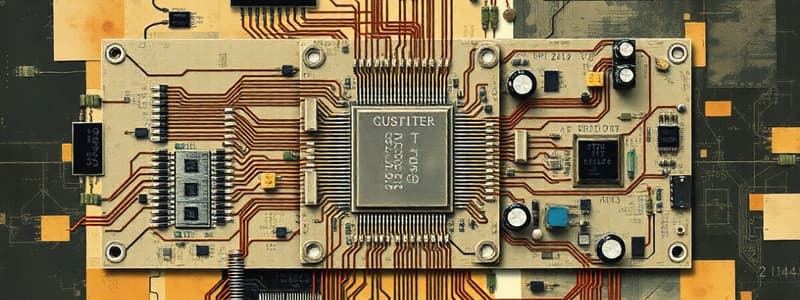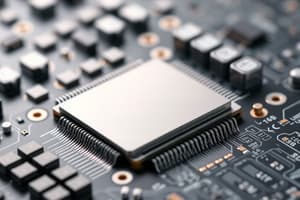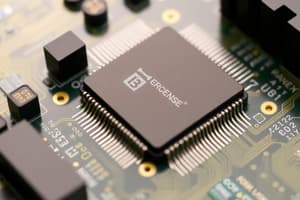Podcast
Questions and Answers
What is the primary function of the accumulator in the Intel 8085A microprocessor?
What is the primary function of the accumulator in the Intel 8085A microprocessor?
- To hold the result of arithmetic operations (correct)
- To manage input/output devices
- To configure the microprocessor clock speed
- To store program instructions
What does the mnemonic 'LDA' represent in assembly language for the Intel 8085?
What does the mnemonic 'LDA' represent in assembly language for the Intel 8085?
- Load Direct Address
- Load Data Address
- Load Accumulator (correct)
- Load Address Directly
Which assembly language command is used to transfer data from the accumulator to an output port?
Which assembly language command is used to transfer data from the accumulator to an output port?
- STA addr (correct)
- MOV addr
- OUT addr
- LDA addr
How many general-purpose registers are connected to the internal data bus in the 8085A microprocessor?
How many general-purpose registers are connected to the internal data bus in the 8085A microprocessor?
What role does the arithmetic logic unit (ALU) perform in the Intel 8085A?
What role does the arithmetic logic unit (ALU) perform in the Intel 8085A?
Which component is responsible for providing chip enables to appropriate ICs in the 8085A microprocessor system?
Which component is responsible for providing chip enables to appropriate ICs in the 8085A microprocessor system?
What type of internal register is the accumulator classified as in the 8085A?
What type of internal register is the accumulator classified as in the 8085A?
Which feature of the 8085A microprocessor aids in managing the timing of its operations?
Which feature of the 8085A microprocessor aids in managing the timing of its operations?
What does the instruction decoder use to determine that 3AH is the code for LDA?
What does the instruction decoder use to determine that 3AH is the code for LDA?
How many times does the instruction decoder increment the program counter for the complete instruction?
How many times does the instruction decoder increment the program counter for the complete instruction?
What address is stored in the address latch register after executing the LDA instruction?
What address is stored in the address latch register after executing the LDA instruction?
What action occurs when the timing and control unit issues a LOW pulse on the RD line?
What action occurs when the timing and control unit issues a LOW pulse on the RD line?
Which instruction is used to read the value from memory location 4000H?
Which instruction is used to read the value from memory location 4000H?
What is the final step in the process described for the instruction execution?
What is the final step in the process described for the instruction execution?
What memory location is used to output the value after the LDA instruction?
What memory location is used to output the value after the LDA instruction?
What does the control bus's LOW CE signal indicate?
What does the control bus's LOW CE signal indicate?
What is the function of the IN port in relation to the accumulator?
What is the function of the IN port in relation to the accumulator?
What does the first byte of an instruction in a microprocessor signify?
What does the first byte of an instruction in a microprocessor signify?
What happens to the outputs when an octal buffer is used for the output port instead of an octal D flip-flop?
What happens to the outputs when an octal buffer is used for the output port instead of an octal D flip-flop?
Which instruction is used in memory-mapped I/O?
Which instruction is used in memory-mapped I/O?
What does the suffix 'addr' in the LDA and STA commands signify?
What does the suffix 'addr' in the LDA and STA commands signify?
When an instruction contains a 16-bit address, how is the order of the address bytes specified?
When an instruction contains a 16-bit address, how is the order of the address bytes specified?
What is the IO/M line state for LDA addr?
What is the IO/M line state for LDA addr?
Why does the input port require three-stated outputs?
Why does the input port require three-stated outputs?
Which opcode is used to jump to a specified address in a microprocessor instruction?
Which opcode is used to jump to a specified address in a microprocessor instruction?
Which command is used to read data into the accumulator?
Which command is used to read data into the accumulator?
What type of LEDs are represented in Figure 17–6?
What type of LEDs are represented in Figure 17–6?
How many external registers does the 8085A microprocessor have?
How many external registers does the 8085A microprocessor have?
What is the purpose of the address decoder IC in a microprocessor system?
What is the purpose of the address decoder IC in a microprocessor system?
Which components of the microcontroller are connected to the data bus?
Which components of the microcontroller are connected to the data bus?
What is assembly language in relation to machine code?
What is assembly language in relation to machine code?
Which instruction is responsible for loading the accumulator with memory contents?
Which instruction is responsible for loading the accumulator with memory contents?
What determines the timing and control signals required to execute an instruction in the 8085A?
What determines the timing and control signals required to execute an instruction in the 8085A?
What is the purpose of U6a and U6b being represented as inverted-input NAND gates?
What is the purpose of U6a and U6b being represented as inverted-input NAND gates?
What does the data bus in a microprocessor architecture need to be bidirectional?
What does the data bus in a microprocessor architecture need to be bidirectional?
What would be the new IN instruction after modifications to inputs A8 and A9?
What would be the new IN instruction after modifications to inputs A8 and A9?
How many bytes does the instruction DCR A require?
How many bytes does the instruction DCR A require?
What is the purpose of decrementing a register using the DCR command?
What is the purpose of decrementing a register using the DCR command?
The hexadecimal value for the byte used to identify the instruction to move data into register A is?
The hexadecimal value for the byte used to identify the instruction to move data into register A is?
What is the purpose of the AS line in the context of the microcontroller?
What is the purpose of the AS line in the context of the microcontroller?
What does the term 'operand' refer to in assembly language?
What does the term 'operand' refer to in assembly language?
What is the function of a compiler in programming?
What is the function of a compiler in programming?
Which of the following best describes the role of the program counter?
Which of the following best describes the role of the program counter?
What type of systems are described as bidirectional?
What type of systems are described as bidirectional?
What does the zero flag in a microprocessor signify?
What does the zero flag in a microprocessor signify?
What component assists a microprocessor in performing input/output tasks?
What component assists a microprocessor in performing input/output tasks?
What is a flowchart used for in programming?
What is a flowchart used for in programming?
Which term refers to the code that identifies instructions to the microprocessor?
Which term refers to the code that identifies instructions to the microprocessor?
Flashcards
Accumulator
Accumulator
An 8-bit internal register in the microprocessor used for temporary storage of data.
8085A
8085A
An 8-bit parallel central processing unit (CPU).
Assembly Language
Assembly Language
Software used to drive microprocessor-based systems.
LDA addr
LDA addr
Signup and view all the flashcards
STA addr
STA addr
Signup and view all the flashcards
Data Bus
Data Bus
Signup and view all the flashcards
Arithmetic Logic Unit (ALU)
Arithmetic Logic Unit (ALU)
Signup and view all the flashcards
Mnemonic
Mnemonic
Signup and view all the flashcards
What does LDA instruction do?
What does LDA instruction do?
Signup and view all the flashcards
What is the purpose of the WR line?
What is the purpose of the WR line?
Signup and view all the flashcards
How does the address latch work?
How does the address latch work?
Signup and view all the flashcards
What is the role of the CE bar?
What is the role of the CE bar?
Signup and view all the flashcards
What is the function of the RD line?
What is the function of the RD line?
Signup and view all the flashcards
What is the purpose of the data bus?
What is the purpose of the data bus?
Signup and view all the flashcards
What does STA instruction do?
What does STA instruction do?
Signup and view all the flashcards
What is memory-mapped I/O?
What is memory-mapped I/O?
Signup and view all the flashcards
Opcode
Opcode
Signup and view all the flashcards
Operand
Operand
Signup and view all the flashcards
Instruction Length
Instruction Length
Signup and view all the flashcards
What does 3E 09H represent?
What does 3E 09H represent?
Signup and view all the flashcards
What does DCR A mean?
What does DCR A mean?
Signup and view all the flashcards
What is a JZ instruction?
What is a JZ instruction?
Signup and view all the flashcards
What is JMP?
What is JMP?
Signup and view all the flashcards
What is the difference between LDA and STA?
What is the difference between LDA and STA?
Signup and view all the flashcards
Input Port
Input Port
Signup and view all the flashcards
Output Port
Output Port
Signup and view all the flashcards
Octal Buffer
Octal Buffer
Signup and view all the flashcards
Octal D Flip-flop
Octal D Flip-flop
Signup and view all the flashcards
MVI r, data
MVI r, data
Signup and view all the flashcards
DCR r
DCR r
Signup and view all the flashcards
Machine Code
Machine Code
Signup and view all the flashcards
Central Processing Unit (CPU)
Central Processing Unit (CPU)
Signup and view all the flashcards
Software
Software
Signup and view all the flashcards
Compiler
Compiler
Signup and view all the flashcards
Flowchart
Flowchart
Signup and view all the flashcards
Control Bus
Control Bus
Signup and view all the flashcards
Memory-mapped I/O
Memory-mapped I/O
Signup and view all the flashcards
I/O-mapped I/O
I/O-mapped I/O
Signup and view all the flashcards
What is the digital level on the IO/M line for memory-mapped I/O?
What is the digital level on the IO/M line for memory-mapped I/O?
Signup and view all the flashcards
What is the digital level on the IO/M line for I/O-mapped I/O?
What is the digital level on the IO/M line for I/O-mapped I/O?
Signup and view all the flashcards
Study Notes
Microprocessor vs Microcontroller
- Microprocessor: A controlling unit, a small chip, performing ALU operations and communicating with connected devices. A single integrated circuit combines several functions.
- Microcontroller: A chip optimized to control electronic devices in single integrated circuits, dedicated to a specific task and application. Contains memory, processor, and I/O.
Key Differences
| Feature | Microprocessor | Microcontroller |
|---|---|---|
| Components | Only Central Processing Unit (CPU) | CPU, Memory, I/O integrated |
| Application | Personal Computers | Embedded systems |
| Interfacing | External bus to RAM, ROM, and peripherals | Internal bus |
| Architecture | Von Neumann | Harvard |
| Cost | High | Low |
| Complexity | High, many instructions | Simple, fewer instructions |
| Power Consumption | High due to external components | Low due to internal components |
| Ideal for | Large-scale systems, general-purpose | Compact systems, power-limited devices |
| Register Count | Fewer, more memory-based operations | More, programs easier to write |
History of Microprocessors
- 1959: Fairchild Semiconductor invented the first integrated circuit (IC).
- 1968: Intel was founded by Robert Noyce, Gordan Moore, and Andrew Grove.
- 1971: Intel created the first microprocessor, the 4004, running at 108 kHz.
- 1973-1978: Second-generation 8-bit microprocessors emerged (Motorola 6800, 6801; Intel 8085; Zilog Z80).
- 1978: Intel 8080 third generation process entered the market.
- Early 1980s: Fourth-generation 32-bit processors from Intel.
- 1995: Fifth-generation 64-bit processors from Intel.
History of Microcontrollers
- 1975: Microcontrollers were first used.
- 1975: Intel introduced the 8048.
- 1993: EEPROM introduction.
- 1993: Atmel introduced the first microcontroller using Flash memory.
Features and Applications
- Microprocessor: Built-in monitor/debugger, parallel I/O, instruction cycle timer, external memory interface
- Microcontroller: Processor reset, program and data memory (RAM), device clocking, instruction cycle timers
- Microprocessor Applications: Calculators, industrial controllers, traffic lights, military applications
- Microcontroller Applications: Mobile phones, automobiles, CD/DVD players, washing machines, cameras, security alarms
Summary
- Key differences lie in their architecture (Von Neumann vs. Harvard), component integration (separate vs. integrated), and target applications (general-purpose vs. embedded).
- Microcontrollers offer a more cost-effective and space-efficient solution for many embedded systems.
Additional Points
- Microprocessors are capable of running at faster speeds due to their complex design.
- Microcontrollers are typically used to control specific tasks in various devices.
- Both, microprocessors and microcontrollers are important components of modern technology.
Studying That Suits You
Use AI to generate personalized quizzes and flashcards to suit your learning preferences.




